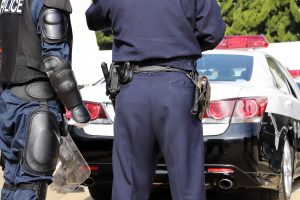Georgia Robbery 101
- Comments Off on Georgia Robbery 101

In Georgia, robbery is committed when a person, with intent to commit theft, takes property of another from the person or the immediate presence of another:
- By use of force;
- By intimidation, by the use of threat or coercion, or by placing such person in fear of immediate serious bodily injury to himself or to another; or
- By sudden snatching. (O.C.G.A. § 16-8-40)
Common examples of robbery are hold ups, bank robberies, store robberies, and home invasions. Robbery is different from the crimes of theft and burglary. Theft occurs when a person unlawfully takes or, after being in lawful possession of property of another, unlawfully appropriates the property of another with the intention of depriving that person of the property. Burglary takes place when a person enters into the building of another without consent and with the intent to commit a felony or theft therein.
Types of Robbery
- Robbery by Use of Force
Robbery by Use of Force is committed when one person, by use of force, takes the property of another from the presence or immediate presence of another. Force is used to take property from the possession of another person. Use of force oftentimes involves personal violence. The force must precede or be contemporaneous with the taking of the property. There is no robbery if force is used after the taking of the property. There is usually a struggle to retain the possession of the property and injury often results as evidence of the struggle. Resistance no matter how slight is always present in robbery by use of force.
- Robbery by Intimidation
Robbery by Intimidation occurs when one person takes the property of another by using threats or coercion, or by placing such person in fear of immediate serious bodily injury. Unlike robbery by force and armed robbery (discussed below), robbery by intimidation may be accomplished without a weapon or an overt act of physical force. Threats of violence with words, actions, and gestures are enough. Holding one’s fist can constitute intimidation if the victim’s response concerning his safety is one that a normal person would experience. Proof that theft was attended with circumstances of terror that induce a person to part with his property for the safety of his person is necessary to secure conviction for robbery by intimidation.
Robbery by intimidation can be a lesser included offense of armed robbery. Prosecutors often allow defendants charged with armed robbery to plead guilty to the crime of robbery by intimidation.
- Robbery by Snatching
Robbery by Snatching occurs when one person suddenly snatches another’s property. No other force is used than what is necessary to obtain possession of the property from the owner who is usually off-guard. Because of the sudden act of the defendant, no resistance by the owner or major injury to a person is necessary to secure conviction for robbery by snatching.
- Armed Robbery
Armed Robbery occurs when offensive weapon, any replica of an offensive weapon, or a device having the appearance of any such weapon is used to take the property of another from the person or immediate presence of another. O.C.G.A. § 16-8-41 (a).
Offensive weapons include not only weapons which are offensive per se such as firearms loaded with live ammunition but also include instruments not normally considered offensive in and of themselves but which may produce death or bodily injury depending on the manner and means of their use. Manner and use do not refer to how weapon was used during robbery but its potential for harm when used offensively. The character of a weapon may be established by direct or circumstantial evidence and may be assessed by the jury during trial. Handguns, knives, toy guns, and pocketknives are examples of weapons most often used in armed robbery.
Use of weapon does not have to be in menacing or threatening manner. The element of “use” is present when victim is aware or made aware of the weapon that has the desired forceful effect of assisting to accomplice the robbery. The test is whether the defendant’s acts created a reasonable apprehension on the part of the victim that an offensive weapon was being used. For example, the slightest display of gun handle could be a sufficient act that can create apprehension on the part of the victim to comply with the demand for his property or money.
Use of a weapon must be prior or contemporaneous with the act of taking. For example, if X is prosecuted for armed robbery by unlawfully taking a cellphone from Y with the use of a handgun, the State is required to prove beyond reasonable doubt that X’s used of handgun occurred prior to or contemporaneously with the taking of Y’s cellphone.
Determining the exact moment when a weapon was used is crucial in probing armed robbery. To illustrate, if in the course of investigation, it was found out that a property is missing and the victim-property-owner was killed, it is important to know which happened first, the taking of property or the killing of the owner. If defendant first took the property then killed the owner who subsequently showed up, there is no armed robbery. However, if defendant killed the owner in order to take the property, there is armed robbery.
When is a property “taken” for purposes of armed robbery? Taking is not a continuing operation which ends only when defendant leaves the presence of the victim. Taking is complete once control of the property is transferred involuntarily from victim to the defendant no matter how briefly.
An armed robbery may be committed even out of the physical presence of the victim if what was taken was under the victim’s control or responsibility and if the victim was not too far distant. Examples of armed robbery committed without the physical presence of victim: 1) If victim X fled the scene to escape or to call for help leaving behind a property that armed defendant Y then took, 2) Defendant shot victims who fled the crime scene leaving behind their car, defendant then took the car, 3) Restaurant cashier left the cash register and went to her manager after defendant displayed weapon, when she returned, cash is gone.
- Robbery of Pharmacy
Robbery of Pharmacy occurs when, in the course of armed robbery, a person unlawfully takes a controlled substance from a pharmacy or a wholesale druggist and intentionally inflicts bodily injury upon any person. O.C.G.A. § 16-8-41 (c).
Penalties and Consequences
Robbery is a serious offense. It is classified in Georgia as a felony. Penalty ranges from one year imprisonment to 20 years. If the victim of robbery is 65 years old or older, the punishment imposed is not less than five years imprisonment. A person convicted of robbery by taking controlled substance from pharmacy in the course of committing offense shall be punished by imprisonment of not less than 15 years.
A person convicted of an armed robbery shall be sentenced to a mandatory minimum imprisonment of ten years. No portion of the mandatory minimum sentence imposed shall be suspended, stayed, probated, deferred, or withheld by the sentencing court. No sentence can be reduced by any form of pardon, parole, or commutation of sentence by the State Board of Pardon and Paroles. Defendant is not eligible for sentencing under First Offender Act.
Where robbery is committed by the use of firearm, separate convictions for armed robbery and possession of a firearm during commission of a crime are authorized by OCGA 16-11-106.
Prosecution and Defenses
It is important to know that a claim of right affirmative defense – where defendant claims that he owns the property he is taking from another or that the person owes him money – does not apply to robbery. Claim of right defense is only available to crime of theft where defendant acted under an honest claim of right to the property or money. To include claim of right defense to robbery would be to authorize or encourage use of threats, coercion, and assaultive behavior to recover property from another.
Most defendants are wearing masks to conceal their identity during robbery. Moreover, robbery often takes place in dark places where defendants can be hardly recognized. It takes special investigative skills to identify the culprits in robbery. Some robbery are solved by confession of conspirators who were offered leniency by the prosecutors in exchange for testimony against another co-accused.
The identification process in robbery investigation involves procedures that must be strictly complied with by law enforcement agencies in order to correctly charge the right perpetrator of the crime and not to commit injustice by charging innocent defendants. Some defendants are wrongly charged with robbery because they were in the “wrong place at the wrong time” when law enforcers picked them up because a robbery incident took place not far from where they are.
Thorough understanding of law enforcement procedures and the Rules of Criminal Procedures is very important to safeguard the rights of defendants charged with robbery. Procedures involving pursuit of defendant following robbery reports, booking procedures, identification procedure during police lineups, and propriety of allowing a conspirators testimony as evidence in robbery prosecution are only few examples of wide variety of procedures available to protect the rights of defendants charged with robbery.
If you or someone you know are charged with robbery, you need Bixon Law on your side. Bixon Law has years of experience protecting the rights of those charged with robbery. Bixon Law has the necessary knowledge and mastery of the procedures involved in law enforcement and criminal prosecution. To schedule an appointment, call Bixon Law at 404-551-5684.









